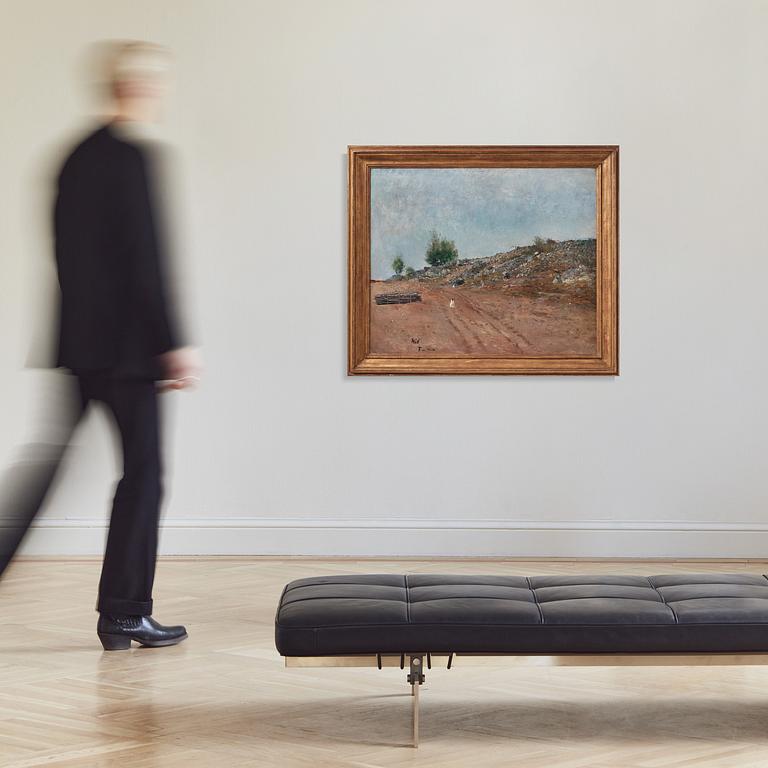Carl Fredrik Hill
"Väg med sittande hund, Fontainebleau" (Road with sitting dog, Fontainebleau)
Signed Hill F-au (Fontainebleau). Executed in 1876. Oil on relined canvas 81 x 101 cm.
Alkuperä - Provenienssi
Mrs. Marie Louise Klason (née Hill, the artist's sister), Stockholm.
By descent within the family.
Bukowski auktioner, Important Spring sale, June 3, 2020, cat no. 396.
Acquired at the above sale.
Näyttelyt
Malmö Museum, Sweden, "Carl Fredrik Hill. Retrospektiv utställning", 1933, no. 54 (under the title "Stenlandskap med vit hund"); Nationalmuseum, Stockholm, "Carl Fredrik Hill 1849-1911", September - October 1949, no. 108 (under the title "Väg med sittande hund"); Liljevalchs Konsthall (Liljevalchs Public Art Gallery), Stockholm, "C F Hill. 'Det sannas hjärta' ", September 18 - November 1, 1987, no. 24 (under the title "Stenbacke med sittande hund"); Nationalmuseum, Stockholm, "Carl Fredrik Hill", October 1, 1999 - January 16, 2000, no. 21; Blaafarvevaerket, Åmot, Norway, "Kong Jeg", May 18 - September 22, 2002; Prins Eugens Waldemarsudde, Stockholm, "Carl Fredrik Hill", September 17, 2011 - January 29, 2012; Nivaagaards Malerisamling, Denmark, "Carl Fredrik Hill. Sveriges store landskabsmaler", October 4, 2015 - January 31, 2016 (under the title "Vej med siddende hund, Fontainebleau").
Kirjallisuus
Adolf Anderberg, "Carl Hill. Hans liv och hans konst", 1951, listed in the catalogue (under "Montigny och Fontainebleautrakten: Juni 1875 samt juli och september 1876") p. 306-307, mentioned p. 226-227 and illustrated full page plate 51 (under the title "Väg med sittande hund"); Viggo Loos, "Friluftsmåleriets genombrott i svensk konst 1860-1885", SAK, 1945, mentioned p. 218 and listed in the catalogue (under the title "Stenlandskap med vit hund") p. 340; (Ed.) Karin Sidén, "Carl Fredrik Hill", exhibition catalogue N:o 615, Nationalmuseum, Stockholm, 1999, illustrated full page in colour, p. 37 and listed in the catalogue, p. 213, no. 21; Sten Åke Nilsson, "Carl Fredrik Hill. Maximus Pictor", 2011, mentioned p. 38 and illustrated full page in colour, p. 105; (Ed.) Birgitte von Folsach and Sten Åke Nilsson, "Carl Fredrik Hill. Sveriges store landskabsmaler", 2015, listed in the catalogue p. 209, no. 44 and illustrated full page in colour, p. 44 (under the title "Vej med siddende hund, Fontainebleau").
Muut tiedot
In 1876 Carl Fredrik Hill produced a number of similar landscape paintings depicting gravel pits or sand hills. "Road with Sitting Dog, Fontainebleau" occupies a central place in this remarkable group of terrain studies, which are united by the sometimes similar basic compositions, where often an open, slightly hilly terrain is partly limited on the horizon by a rising forest skyline.
The present catalog number shows striking similarities with "Forêt de Fontainebleau" (oil on canvas, 81 x 100 cm, 1876, Sven-Harrys Konstmuseum, Stockholm, sold at Bukowskis in spring 2003), which was executed in the same place at the same time. It is not at all impossible that the similar compositions were executed just a few days apart. In these paintings, the landscape has been depicted with palpable, sometimes brutal, truth, but the artist has not completely excluded poetry. A pleasantly balancing French light rests over the foreground, while at the same time making the delicate greenery of the bushes play pleasantly and beautifully against the blue shimmer of the underlying sky.
In his extensive work "Carl Hill. Hans liv och hans konst' (1951) discusses the 1876 landscape paintings from Fontainebleau as follows:
"This desolate rocky ground, over which the sun had free rein, had a transformative effect on both his color vision and his method of representation. He felt liberated, released from the spell of the dark Barbizon forests [...] The grandeur of nature, its solitude, its oblivion, spoke directly to Hill's mind. He was seized by a strong sense of communion with these wastelands. In interpreting them, he poured much of what burned and burned within him. Self-portraits of the artist could not seem more revealing than these pictures, which were created in an often ecstatic state of mind."
Professor Sten Åke Nilsson develops this argument further in the National Museum's exhibition catalog "Carl Fredrik Hill" (1999/2000):
"Several paintings from this summer are inscribed Fontainebleau and seem to have been made in the same place, in an abandoned gravel pit. From a sketch, we see that Hill found the entrance to this landscape quite directly, but the series of studies shows that he had an important artistic problem to solve here; it is as if he was involved in a chess game with a few remaining pieces. A few bushes stretch like green fires towards the sky. The light is equally intense everywhere. The scenery is varied as much as possible; a battered fence and a pile of sturgeon return again and again, a small dog and a man dressed in blue appear and disappear, they are the only living creatures, otherwise the motif offers only gravel and shards of stone. It is a terrain full of wounds'.






























































